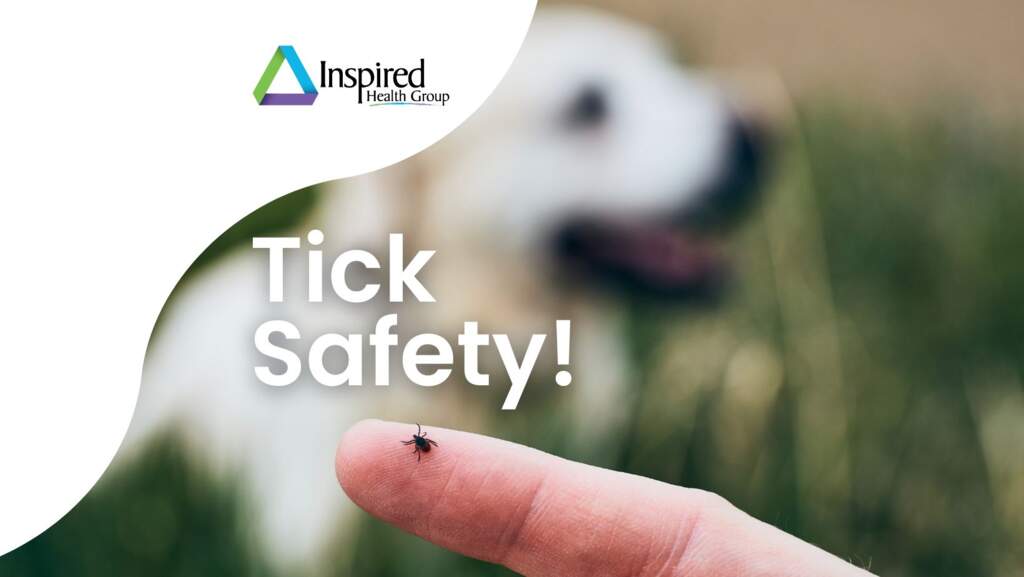May 29, 2024
Prevent, Check & Treat Tick Bites
While there are several diseases that can be transmitted by ticks, Lyme disease is the most commonly reported in New York State. An average of more than 9,000 cases are reported in NYS each year. Lyme disease is a bacterial infection that is spread by a bite from an infected blacklegged tick, also known as a deer tick. Blacklegged ticks can spread other tickborne diseases as well.
Symptoms of Lyme disease include:
- fever
- headache
- fatigue
- skin rash called erythema migrans
Lyme disease is diagnosed based on:
- symptoms
- physical findings (such as a rash)
- possibility of exposure to infected ticks
- Laboratory testing is helpful if used correctly and performed with validated methods
Most cases of Lyme disease can be treated successfully with a few weeks of antibiotics. If left untreated, infection can spread to joints, the heart, and the nervous system.
Prevent tick bites and the spread of Lyme Disease:
Before You Go Outdoors
Know where to expect ticks:
- Ticks live in grassy, brushy, or wooded areas, or even on animals. Spending time outside walking your dog, camping, gardening, or hunting could bring you in close contact with ticks. Many people get ticks in their own yard or neighborhood.
- Check your Tick Risk Score by Region
Dress to avoid contact:
- Wear long pants and long-sleeved shirts for protection
- Light colored clothing is best because it allows for greater visibility of ticks
- Tucking your shirt into your pants and your pants into your socks provides additional protection
Consider using a Tick Repellant:
- Treat clothing and gear with products containing 0.5% permethrin. Permethrin can be used to treat boots, clothing and camping gear and remain protective through several washings.
- Alternatively, you can buy permethrin-treated clothing and gear.
- Use Environmental Protection Agency (EPA)-registered insect repellents containing DEET, picaridin, IR3535, Oil of Lemon Eucalyptus (OLE), para-menthane-diol (PMD), or 2-undecanone. EPA’s helpful search tool can help you find the product that best suits your needs. Always follow product instructions. Do not use products containing OLE or PMD on children under 3 years old.
- Apply repellents outdoors only
- Wash off repellents when you go indoors
- Don't spray your face with repellent
- Don't breathe repellents
- Don't put repellent on cuts, sunburns or rashes
- Don't put repellent on little kids' hands
- Don't use repellent under clothes
While outdoors:
- Avoid wooded and brushy areas with high grass and leaf litter
- Walk in the center of trails and paths
- Check for ticks often while outdoors and brush off any before they attach
After You Come Indoors
- Check your clothing for ticks. Ticks may be carried into the house on clothing. Any ticks that are found should be removed.
- Tumble dry clothes in a dryer on high heat for 10 minutes to kill ticks on dry clothing after you come indoors. If the clothes are damp, additional time may be needed. If the clothes require washing first, hot water is recommended. Cold and medium temperature water will not kill ticks.
- Examine gear and pets. Ticks can ride into the home on clothing and pets, then attach to a person later, so carefully examine pets, coats, and daypacks.
- Shower soon after being outdoors. Showering within two hours of coming indoors has been shown to reduce your risk of getting Lyme disease and may be effective in reducing the risk of other tick borne diseases. Showering may help wash off unattached ticks and it is a good opportunity to do a tick check.
- Check your body for ticks after being outdoors. Conduct a full body check upon return from potentially tick-infested areas, including your own backyard. Use a hand-held or full-length mirror to view all parts of your body. Check these parts of your body and your child’s body for ticks:
- Under the arms
- In and around the ears
- Inside belly button
- Back of the knees
- In and around the hair
- Between the legs
- Around the waist
- Remember to check pets for ticks after spending time outdoors and talk to your veterinarian about ways to reduce ticks on your pet.
If you find a tick attached to your skin, there’s no need to panic—the key is to remove the tick as soon as possible. Although there are tick removal devices on the market, a plain set of fine-tipped tweezers work very well.
How to remove a tick
- Use fine-tipped tweezers to grasp the tick as close to the skin’s surface as possible.
- Pull upward with steady, even pressure. Don’t twist or jerk the tick; this can cause the mouth-parts to break off and remain in the skin. If this happens, remove the mouth-parts with tweezers. If you are unable to remove the mouth easily with clean tweezers, leave it alone and let the skin heal.
- After removing the tick, thoroughly clean the bite area and your hands with rubbing alcohol or soap and water.
- Never crush a tick with your fingers. Dispose of a live tick by putting it in alcohol, placing it in a sealed bag/container, wrapping it tightly in tape, or flushing it down the toilet.
Follow-up
If you develop a rash or fever within several weeks of removing a tick, see your care provider. Be sure to tell the your care provider about your recent tick bite, when the bite occurred, and where you most likely acquired the tick. If you have questions or concerns about a tick exposure, contact the Inspired Health Group care team.
Learn more about tick removal and symptoms to check for here!
Tick Testing is Available From:
The Insect Diagnostic Lab at Cornell University; email: IDLDiagnosticLab@cornell.edu
Ticknology; (970)305-5587
TickReport; (413)545-1057
TickCheck; (866)713-TICK
